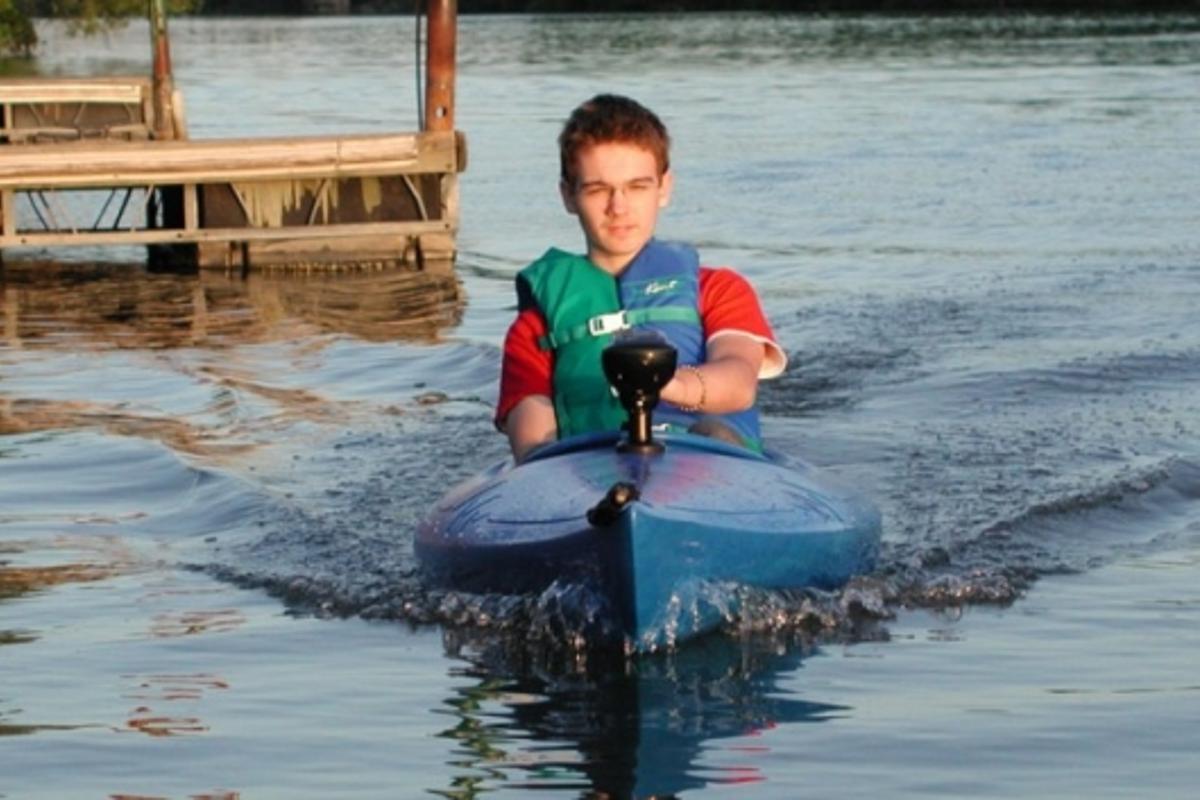February 6, 2008 We've seen some exciting examples of motorized kayaks in the past including Surfango's 9.5hp, 25mph PowerKayak, but when speed isn't the primary objective, the electric option offers some key benefits over combustion engine designs - it's low maintenance, cost-effective, non-polluting and best of all it doesn't destroy the peace and tranquility of being on the water the way a 4-stroke does, making it ideal for pursuits such as birdwatching, fishing or photography. Kayacht offer an electric-propulsion solution that will bring these benefits to almost any existing kayak hull. Using a short shaft 30 lb thrust Minnkota motor with 5-speed forward and 3-speed reverse, the add-on system delivers a leisurely 5-6mph cruising speed for around 45 minutes, or for several hours at slower speeds or when using the paddle assist mode.
Capable of being steered by either helm or paddle, the MotorYak(TM) Electric Propulsion system uses 25 lb (11.3 kg) VRSLA / AGM type spill proof batteries that are easy to change, resistant to vibration and tilting, do not require special ventilation and boast up to three times the expected life of a standard wet-cell batteries. The batteries also hold charge efficiently over time, dropping only losing 1-3% of their charge per month so when you drag the kayak out after its winter hibernation there should still be some juice in the system. There's also a multiple battery option that uses switchable series wiring or a parallel battery system that draws power evenly from each battery to prevent any individual battery being totally drained. According to Kayacht a fully-charged battery will provide four hours of cruising at slow speed on a single charge without having to paddle.
The system also uses a specially designed Bow Thruster(TM) motor mount that enhances maneuverability, stopping power and straight-line tracking by virtue of its forward location which pulls, rather than pushes the boat.
Unlike using a conventional outboard motor, the steering controls are positioned in front for easy access and a safety kill switch cuts power if the operator is out of the boat. A "dash" mounted battery "fuel" gauge incorporating a battery test switch lets you keep an eye on power reserves and numerous add-on options are available to complement the system including a customizable control console, solar panels for trickle charging or power assist, running lights and a speedometer. Larger motors (up to 103 lbs) are also available. The idea took began to take shape about six years ago when Paul Howey started to investigate the possibility of promoting electric boats online. After encountering much confusion and lack of cooperation between manufacturers and websites in the industry the idea was eventually abandoned but a second valuable lesson from the exercise - the difficulty in finding an electric boat to suit his tastes, led Howey to development of the Kayacht system.
"Most electric boats were far too expensive, overbuilt and geared towards the luxury / leisure-boating retirement market. So I set my sights on designing a fun user-friendly electric kayak mostly just for myself to start, nothing formal. But the idea took shape fast and far exceeded my original expectations", says Howey. "Actually, the whole idea of paddling a kayak never appealed much to me. Not that it's not good exercise or a great sport, it is. But as for me, when I get in a boat I am not looking to do any work. I am looking to relax and enjoy myself".
After building and testing the prototype (with great feedback from his kids!) the idea began to move towards commercial reality. "I didn't really set out to make a commercially viable watercraft per se but the idea quickly turned into that. This led to conversion kits to retrofit existing kayaks to electric propulsion". The DIY propulsion kit is suitable for many makes of kayak but works best with fairly flat or slightly curved bottom hulls and the use of the Perception Mainstream Brand Riptide or Streak Sit-In Hulls is recommended.
The system takes just a couple of hours to install (with a few basic skills) and the company also offer a complete, custom-built electric powered kayak.
The various components of the kit can be purchased separately or as a whole with the Plans, Motor Mount & New Modified 30 lb Thrust Motor costing USD$295.00 and the Electrical & Hardware Kit available for USD$169.00. The complete pre-assembled Electric Kayak including hull costs USD$1395 (batteries and charger not included). For further info see Kayacht.









